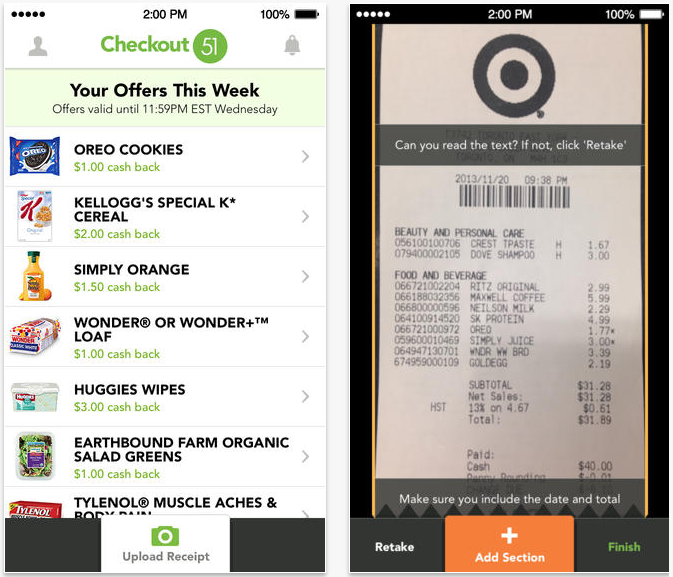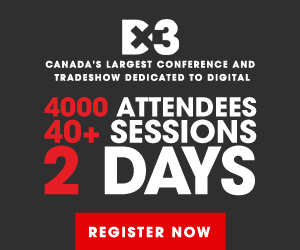
Checkout 51’s primer is pretty simple: “Every Thursday morning, Checkout 51 updates with a new list of offers. All you have to do is pick the ones you like, purchase them at any store, and upload a photo of your receipt through our mobile app or website. When your account reaches $20, we send you a check.”
There is something effortless, even magical, about the process; these are groceries you would have purchased anyway. Well, maybe not the exact ones, but you were going to buy tea — now you’ll just opt for Lipton’s. You were going to buy ice cream bars — now you’ll get Magnum. But Checkout 51 isn’t processing cheques out of the goodness of its heart: there is a core business behind it, and it comes in the form of data. Your data.
“The value proposition we offer is as a data company,” Kristie Painting, VP of Sales at Checkout 51, tells me. “When we see the [user-uploaded] receipts every week, we get a lot of information off it. We see what store the user shopped at, the day of the week, the time of day, basket size and type of payment.” All that data — what you buy, when you buy and where you buy it — is aggregated into a huge database, which is then shared with the companies behind the brands being promoted through the coupons.
“We’re retail-agnostic,” Painting continues. Checkout 51 sees its core disruption as sidestepping the retailers themselves; it doesn’t matter where the user shops, as long as brands they’re buying are being promoted through the app. For many coupon users, this is a digitized form of the same routine they’ve kept for years, but with a twist: after a length of time, Checkout 51 knows a lot about you and your buying habits, and begins offering targeted coupons in place of unused ones.

The app, available on iOS and Android, and recently expanded to the US after staging in Canada, is a practice in design simplicity. The onboarding process rewards new users with $2 just for uploading a grocery receipt; bread and milk purchases, regardless of brand, contribute 50 cents towards the $20 target. And receipts are not required to be in paper form: Checkout 51 recently expanded to the web, and allows users of online portals, like Grocery Gateway and Walmart, to submit without a smartphone.
Smartphones, however, are still the main conduit. Painting says the vast majority of Canadians use their phones to take photos of paper receipts; the web interface was launched to satiate demand in the States, where smartphone penetration is much lower. According to Painting, iOS is still the platform of choice, with 65% of submissions; Android comprises 30% and the web just 5%.
The submission process is a hybrid of manual sorting and OCR, or Optical Character Recognition, which Painting says is used to differentiate and quality individual receipts from among the thousands submitted every week. The system targets 10 points of a receipt, from the retailer to the time to the order of the products scanned, to prevent fraud. Each receipt is itemized under a user’s account, so handing the same receipt to a friend or family member will yield a failed result.
During its two-month availability window in the United States, Checkout 51 has already processed 400,000 offers, and there are over half a million members in the database. The Canadian market is more mature, with 650,000 users and over a million coupons redeemed. The company plans to use the treasure trove of purchase data to work with its customers — the aforementioned parent companies of brands like Lipton and Magnum — to initiate retail-independent loyalty programs. Painting also describes a future where unique coupons will be embedded into websites and social networks like Facebook, so community managers can “reward” loyal customers with discounts on future products. There’s also the potential for geographically-targeted offers using technologies like Apple’s iBeacon, which is making its way into more retailers in 2014.
As Checkout 51 grows, its data becomes more valuable to the companies it works with; the quarterly and annual summary charts of buyer behaviour become as useful to the brands involved as Foursquare check-ins are to advertisers. People need to eat, and will continue to search out ways to pay less for groceries; Checkout 51 is in an enviable position of being in the middle of those inevitable transactions, providing value to both sides.
—
Kristie Painting will be giving a talk titled The 5 Things You Need to Know About Mobile Couponing during the Dx3 conference in Toronto on March 6th.
If you’re planning on attending Dx3 then you might want to save a bit of cash as they have extended a $40 discount to those who want it, tickets will now cost $359 if you use the promo code DX3MS.
MobileSyrup may earn a commission from purchases made via our links, which helps fund the journalism we provide free on our website. These links do not influence our editorial content. Support us here.



